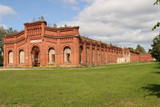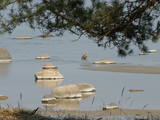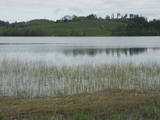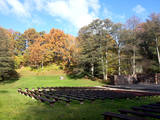| Nr | Nosaukums | Apraksts |
|---|---|---|
|
Ciems atrodas pie Irbes (Dižirve, Īra) upes ietekas jūrā, abos tās krastos („jūrspuse” un „zemspuse”). Irbe pirmoreiz minēta 1310. g. robežlīgumā starp Kurzemes bīskapu un Rīgas domkapitulu, bet Lielirbes (Irvemünde) vārds pirmoreiz ierakstīts 1387. g. šķīrējtiesas dokumentā. 19. gs. beigās Lielirbes sīkosta bija aktīvs kokmateriālu tirdzniecības un transporta centrs. 19. gs. beigās un 20. gs. sākumā te uzbūvēts lielākais burinieku skaits Kurzemes rietumkrasta ciemos. 1939. g. ciemā bija ap 300 iedzīvotāju, vairāk kā 70 māju un baptistu baznīca (tagad Ventspils Brīvdabas muzejā). Ciemam cauri kursēja mazbānītis, darbojās pasta un telegrāfa kantoris, divi pārtikas veikali, 1. pakāpes pamatskola, koris un pūtēju orķestris. Lielirbe bija viens no lielākajiem ciemiem, kas izzuda pēc Otrā pasaules kara. Lielirbē dzimusi kultūrvēsturniece Valda Marija Šuvcāne (1923 - 2007), kuras darbu turpina viņas meita Baiba Šuvcāne, rakstot nozīmīgus darbus par Lībiešu krasta dzīvi. Līdz 2019. g. pāri Irbes upei plānots atjaunot trošu tiltu. |
||
|
Lielākā Kuršu kāpu apdzīvotā vieta (~ 1,1 tūkstotis iedzīvotāju pēc 2001. g. datiem) – sens kursenieku ciems. Nidas pirmsākumi dokumentos minēti jau 1385. g. Līdz 19. gs. beigām Nidas iedzīvotāju galvenā nodarbošanās bija zvejniecība. 19. – 20. gs. mijā Nida kļuva par iecienītu kūrortu. Līdzīgi kā citi ciemi, arī Nida ir tikusi vairakkārt „pārcelta", klejojošo kāpu dēļ. Nidas apskatei ir jāplāno nepilna diena. Te ir daudz muzeji – Neringas vēstures muzejs, Dzintara muzeja galerija, Nidas mākslas galerija, Etnogrāfiskā zvejnieka sēta un dažādi pieminekļi. Tūrisma sezonas laikā te atpūšas ~ 200 000 – 300 000 vasarnieku. Varbūt tas ir pamatots iemesls, lai uz Nidu labāk atbrauktu pavasarī vai rudenī? Daži interesantākie apskates objekti ir aprakstīti tālāk. |
||
|
Celta 1835. g. kā baronu fon Firksu dzimtas īpašums pēc baroneses Teas fon Firksas pasūtījuma. 1883. g. pēc pārbūves ēka ieguva greznu manierisma un renesanses formu dekoratīvo apdari un lielāku būvapjomu. 1905. g. 15. decembrī muižas ēku nodedzināja revolucionāri. Atjaunošanas darbi arhitekta L. Reinīra vadībā tika uzsākti trīs gadus vēlāk. Muižas pilī apskatāma Svētku zāle ar diviem marmora kamīniem, atsevišķās telpās - 20. gs. sākumā liktais parkets un ārdurvju vērtnes ar metālkalumiem. 1938. g. pili pārbūvē. 2. pasaules kara laikā ēkā atrodas vācu armijas karavīru hospitālis, pēckara gados – mežu darbinieku skola. No 1962. g. pilī izvieto Rudbāržu skolu, kas nosaukta Oskara Kalpaka vārdā. Pie ēkas novietota piemiņas plāksne, kas veltīta Kalpaka bataljona gaitām. Latvijas Brīvības cīņu laikā 1919. g. 22. janvārī lielinieki bija ieņēmuši Skrundu. Septiņas dienas vēlāk O. Kalpaka bataljons no Rudbāržu muižas devās Skrundas virzienā. Pēc trīs stundu ilgas cīņas tas guva uzvaru, ieņemot stratēģisko līniju Ventas krasta tuvumā. Šī bija kalpakiešu pirmā uzvara pēc daudzkārtējas atkāpšanās, kas tiem deva iedvesmu turpmākajās cīņās. Rudbāržu muižas Varoņu zāle, kas stāsta par nozīmīgiem posmiem Latvijas Brīvības cīņās, restaurēta 2016. gadā. |
||
|
Atrodas Riekstusalas pussalas galā. No tā labi pārskatāma aizaugušā Kaņiera ezera ziemeļu un austrumu daļa. Izcila putnu vērošanas vieta. Pie torņa atrodas viena no retajām Latvijas kadiķu audzēm. Turpat meklējams Kaņiera ezera niedru laipas (uz pontoniem) sākums. |
||
|
This is for birders who can’t afford to take longer breaks to enjoy birdwatching. Short but rewarding trip during spring migration. Cape Kolka is a place where pass the largest numbers of migrating birds in the spring time. More than several tenth of thousand birds cross the Cape each hour. During active period of migration it is possible to see more than 100 different species daily just at this one place. There are several birdwaching places located at different biotops – seaside meadows, sea cost and lakes and wetlands. Kemeri National Park is one of the best places for woodepecker watching. In a short period of time it is possible to see about seven species. |
||
|
Ražo piena pārstrādes produktus un audzē zemenes. Viesiem piedāvā apgūt rudzu maizes cepšanu, siera siešanu, saldējuma gatavošanu un dzīvnieku (aitas, kazas, cūkas, teļi, govis, zirgi, vistas, truši, jūrascūciņas u.c.) apskati. Entuziasti var piedalīties lauku sētas darbos, degustēt un iegādāties produkciju. |
||
|
Atrodas ~ 0,4 km no Latvijas – Lietuvas robežas, Sventājas ielejas labā krasta nogāzē. Atrodama informācija, ka avotu tīrot, atklājusies 5 x 5 m ozolkoka „grīda”. Avots ir labiekārtots – virs tā slejas lapene ar niedru jumtu. Vēl pavisam nesen pie tā auga Latvijas dižākā ieva (nolūza), kuras vietā tagad kuplo biezs atvašu pulks. |
||
|
Kafejnīca "Stūrītis" atrodas Talsu centrā pie Baznīcas laukuma. Latviešu virtuve: Pupiņu, skābeņu un aukstā zupa, grūbu vai zirņu putra, bukstiņputra, dārzeņu un gaļas sautējumi, mājas kotletes, pelēkie zirņi ar speķi, cūkgaļas ribiņas, kartupeļu pankūkas, uzpūtenis, ķīselis ar pienu. |
||
|
Manēža (celta 1903. – 1904.) bija Karostas militāro treniņu, vingrinājumu un svinīgu pasākumu norises vieta. Dienvidu piebūvē (nav saglabājusies) atradās neliela baznīciņa. Manēžā notika ģimnastikas uzvedumi un sacensības jātnieku veiklības vingrinājumos. Tajā rīkoja oficiālas maltītes garnizona matrožiem, kur vienlaikus apkalpoja līdz 3000 cilvēkiem. Diemžēl līdz mūsdienām ir saglabājušās tikai „plikas” ēkas sienas. Manēžas apskate no ārpuses un iekšpuses jebkurā laikā. Vienīgā šāda veida un izmēra slēgta tipa celtne Latvijā, kuras jumta pārsegumā bija iestrādātas stikla kārniņu joslas.
|
||
|
This long tour of Latvia includes some of the best and most beautiful parts of Jūrtaka in Latvia. Hikes along the sea alternate with trips and excursions in the cities. You will go along the coast of the Baltic Sea from Mazirbe to Kolka, seeing Slītere National Park and Livonian villages. You will see Engure Nature Park and the overgrown seaside meadows that are suitable for bird watching. Along the way, you will be able to purchase smoked fish from local fishermen and learn about fishing traditions in Latvia. Further, the route will take you through the most popular seaside resort in Latvia, Jūrmala; you will also have time to visit the capital city - Rīga. The second part of the route runs along the Vidzeme coast from Saulkrasti to Svētciems. In terms of landscapes and views, the most multifaceted section of the Baltic Coastal Hiking Route in Latvia, which includes both sandy and rocky beach, coastal meadows, reeds, dunes, sandstone outcrops, forests, capes and small coves, fishing villages and pubs. |
||
|
„Rīgas jūras līča rietumu piekraste” - nozīmīga patvēruma un barošanās vieta lielam skaitam migrējošo putnu sugu visa gada garumā. Biežāk sastopamās aizsargājamās putnu sugas – brūnkakla un melnkakla gārgale, jūrmalas dižpīle, kākaulis, tumšā pīle un mazais ķīris, teritorija ir nozīmīga arī rifu aizsardzībai. Teritorija atrodas iepretim Dundagas, Rojas un Engures novadam, kā arī Jūrmalas pilsētai, tās platība ir 132 173 ha. Teritorija ietver dabas parka „Engure” un Ķemeru nacionālā parka jūras daļu.
|
||
|
Tās celtniecību uzsāka 1830. g. par muižkunga Ludviga Šabanska ziedotajiem līdzekļiem. No laukakmeņiem celtajā baroka stila dievnamā, kuru apjož atjaunots akmens žogs, atrodas svētbildes „ Jēzus sirds", „Kristus ciešanas", „Svētais Jāzeps". Ikdienā apskatāma no ārpuses. |
||
|
Dabas parks veidots Burzavas pauguraines, Adamovas ezera (eitrofs ezers) un tā krastos sastopamo biotopu un sugu, t.sk. sikspārņu aizsardzībai. Visskaistākie skati uz dabas parku paveras no pauguriem, kas atrodas ezera ziemeļu krastā. Ezera krastos atpūtu piedāvā vairākas naktsmītnes, bet parka tuvākajā apkārtnē tūristus uzņem populāri Latgales novada podnieki. |
||
|
Vecpiebalgas vecajos kapos (Vecpiebalgas austrumdaļā, pa ceļam uz "Saulrietiem" un "Vēveriem") apskatāms piemineklis, kas veltīts brāļu Kaudzīšu romāna "Mērnieku laiki" personāžam - Lienai. Piemineklis uzstādīts 1987. g. (tēlniece M. Baltiņa). Pirms ceļojuma atkal ir jāpāršķirsta "Mērnieku laiki"! |
||
|
Pankūku kafejnīca. Dažādi oriģināli pildījumi. Kafejnīca piedāvā svaigi grauzdētu kafiju, kafijas un alkoholiskos dzērienus, kā arī uzkodas. Atvērta tipa virtuve. |
||
|
Brīvdabas estrāde atrodas ainaviski skaistā vietā - Ziedulejā. Vasarā te notiek kultūras pasākumi – koncerti, teātra izrādes, balles, Jāņu ielīgošana u.c. Starptautiskais burdona festivāls ik pēc četriem gadiem (nākamais notiks 2020. gadā) te pulcē burdona dziedātājus no daudzām pasaules valstīm. |
||
|
Rīgas HES komplekss ir savienots ar Doles salas austrumdaļu. Rīgas HES ir pēdējā no elektrostacijām Daugavas HES kaskādē. Tās celtniecību uzsāka 1966. g., bet pirmo hidroagregātu iedarbināja 1974. gadā, tā projektēto jaudu sasniedzot divus gadus vēlāk. Rīgas HES uzstādīti seši hidroagregāti, kuru kopējā jauda ir 402 000 kW. No Rīgas – Daugavpils šosejas (A 6) labi redzamas Rīgas HES dambis. Rīgas HES dzelmē palika daudzi kultūras un vēstures pieminekļi, t.sk. Laukskolas apmetne, kas ir vecākā zināmā cilvēku apmešanās vieta tagadējā Latvijas teritorijā. |
||
|
Kādreizējās Tabivere muižas vējdzirnavās darina dažādu garšu mājas alu. Dzirnavās iespējams degustēt alu kopā ar uzkodām, kā arī tiek rīkotas meistarklases. |
||
|
Viens no lielākajiem cilvēka veidotajiem Latvijasparkiem (70 ha), kas izstiepies no Liepājas ostas līdz Dienvidu fortam > 3 km garumā. Tā izveidi uzsāka jau 1870. g. pēc pilsētas mēra K. Ūliha iniciatīvas, uzbūvējot kūrmāju un strūklaku. 19. - 20. gs. mijā ap Dzintaru un Liepu ielām parādījās greznu villu un savrupmāju apbūve. Viena no skaistākajām ir jūgendstilā celtā savrupmāja Liepu ielā 27, kurā atrodas Krievijas ģenerālkonsultāts. Ēkai ir slēgta uzeja, balkoni, pildrežģa konstrukcijas un kārniņu jumts (arhitekti G. Jenike un P. M. Berči). Jūrmalas parks visās sezonās ir iecienīta pastaigu un dažādu aktivitāšu norises vieta. Te meklējams stadions „Daugava”, tenisa korti, koncertestrāde “Pūt, vējiņi!”, vasaras kafejnīcas, minigolfa laukums, bērnu rotaļu laukums, skeitparks. Šeit meklējamas lielākās Latvijas bungas – vides dizaina objekts. |
||
|
Viens no izcilākajiem Baltijas ūdenskritumiem – ap 8 m augsts un līdz 70 m plats (iespaidīgāks pavasaros un pēc lietavām). Ūdenskritums un tam sekojošais ~ 300 m garais kanjons veidojies Ordovika perioda kaļķakmeņos, kuros zinātājs saskatīs galvkāju u.c. fosīlijas. Mazūdens periodā drosmīgākie mēģina šķērsot upes straumi gan virs ūdenskrituma, gan arī zem tā, kur kaļķakmens pārkares un krītošais ūdens ir izveidojuši savdabīgu „tuneli”.
|
||


























